air filter Alfa Romeo Giulietta 2017 Owner's Manual
[x] Cancel search | Manufacturer: ALFA ROMEO, Model Year: 2017, Model line: Giulietta, Model: Alfa Romeo Giulietta 2017Pages: 212, PDF Size: 4.56 MB
Page 123 of 212
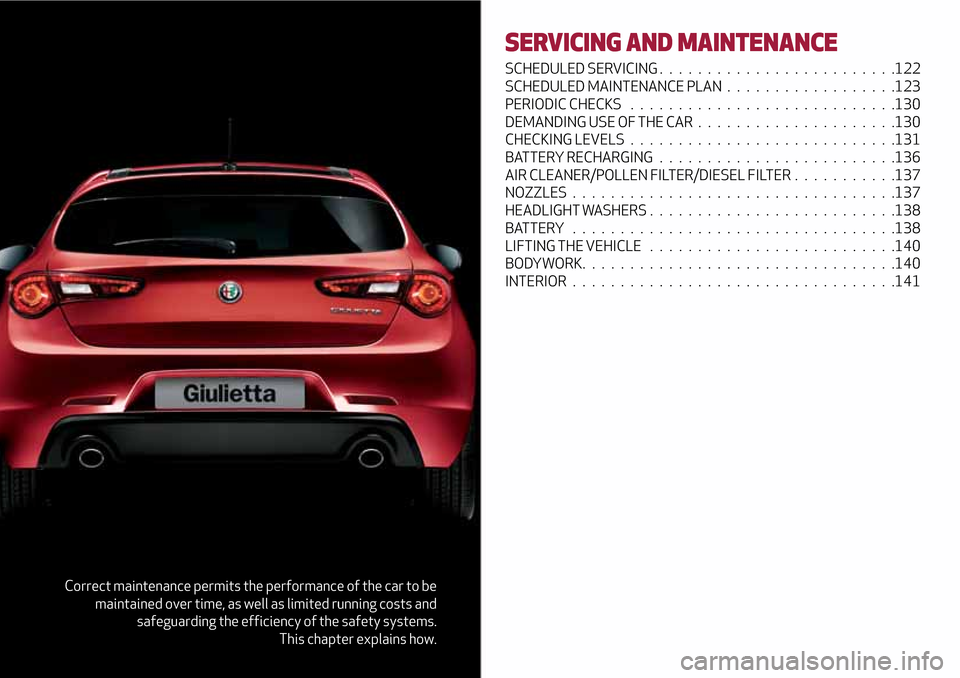
Correct maintenance permits the performance of the car to be
maintained over time, as well as limited running costs and
safeguarding the efficiency of the safety systems.
This chapter explains how.
SERVICING AND MAINTENANCE
SCHEDULED SERVICING.........................122
SCHEDULED MAINTENANCE PLAN..................123
PERIODIC CHECKS............................130
DEMANDING USE OF THE CAR.....................130
CHECKING LEVELS ............................131
BATTERY RECHARGING .........................136
AIR CLEANER/POLLEN FILTER/DIESEL FILTER...........137
NOZZLES..................................137
HEADLIGHT WASHERS..........................138
BATTERY..................................138
LIFTING THE VEHICLE . .........................140
BODYWORK.................................140
INTERIOR..................................141
Page 127 of 212
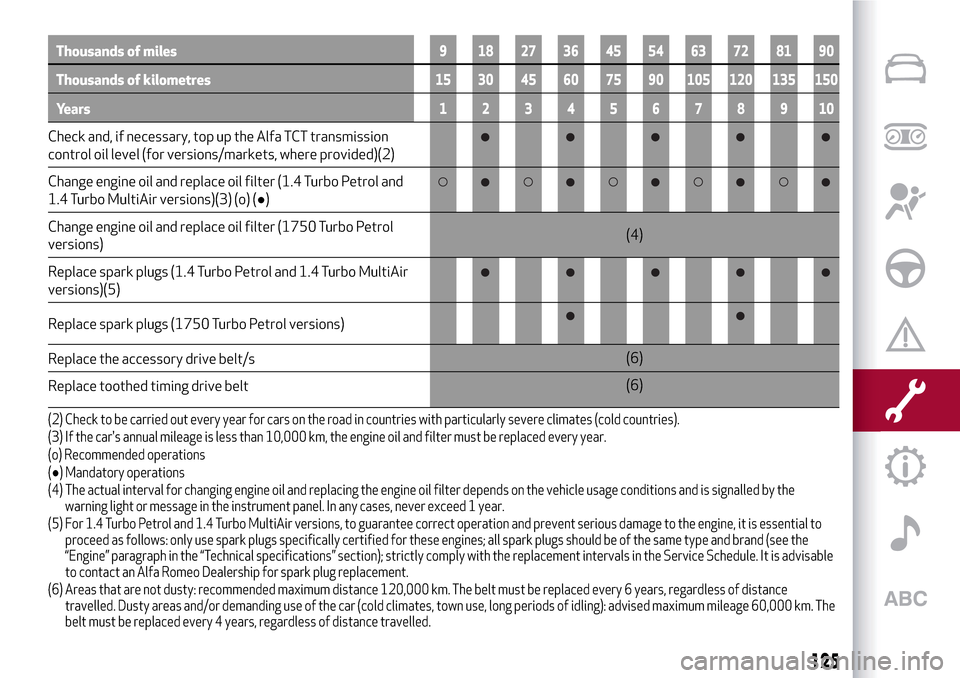
Thousands of miles9 182736455463728190
Thousands of kilometres15 30 45 60 75 90 105 120 135 150
Years12345678910
Check and, if necessary, top up the Alfa TCT transmission
control oil level (for versions/markets, where provided)(2)
Change engine oil and replace oil filter (1.4 Turbo Petrol and
1.4 Turbo MultiAir versions)(3) (o) (●)
Change engine oil and replace oil filter (1750 Turbo Petrol
versions)(4)
Replace spark plugs (1.4 Turbo Petrol and 1.4 Turbo MultiAir
versions)(5)
Replace spark plugs (1750 Turbo Petrol versions)
Replace the accessory drive belt/s(6)
Replace toothed timing drive belt(6)
(2) Check to be carried out every year for cars on the road in countries with particularly severe climates (cold countries).
(3) If the car's annual mileage is less than 10,000 km, the engine oil and filter must be replaced every year.
(o) Recommended operations
(●) Mandatory operations
(4) The actual interval for changing engine oil and replacing the engine oil filter depends on the vehicle usage conditions and is signalled by the
warning light or message in the instrument panel. In any cases, never exceed 1 year.
(5) For 1.4 Turbo Petrol and 1.4 Turbo MultiAir versions, to guarantee correct operation and prevent serious damage to the engine, it is essential to
proceed as follows: only use spark plugs specifically certified for these engines; all spark plugs should be of the same type and brand (see the
“Engine” paragraph in the “Technical specifications” section); strictly comply with the replacement intervals in the Service Schedule. It is advisable
to contact an Alfa Romeo Dealership for spark plug replacement.
(6) Areas that are not dusty: recommended maximum distance 120,000 km. The belt must be replaced every 6 years, regardless of distance
travelled. Dusty areas and/or demanding use of the car (cold climates, town use, long periods of idling): advised maximum mileage 60,000 km. The
belt must be replaced every 4 years, regardless of distance travelled.
125
Page 128 of 212
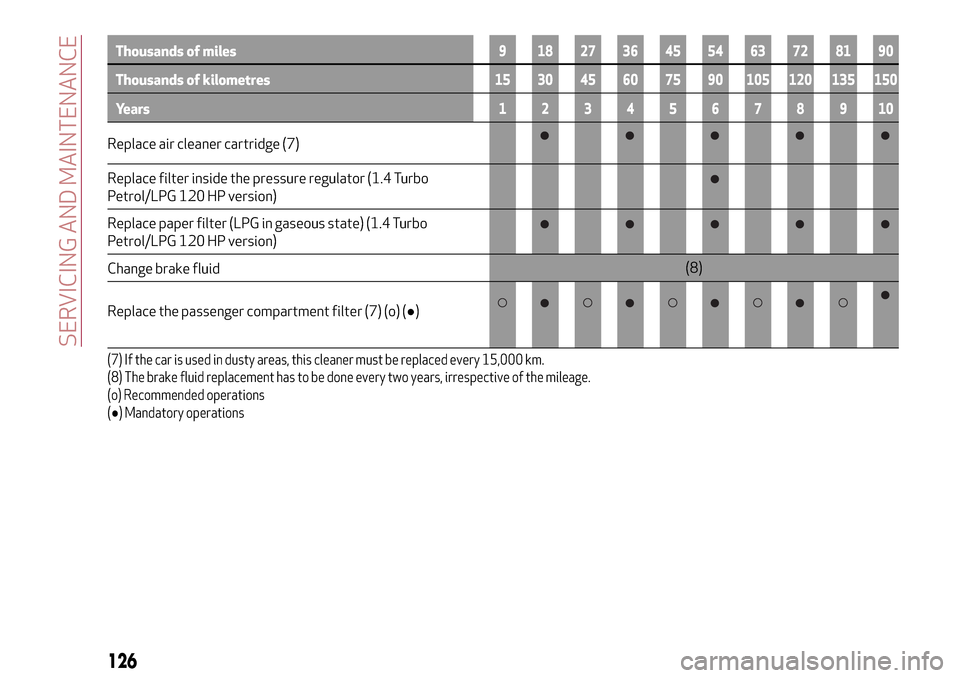
Thousands of miles9 182736455463728190
Thousands of kilometres15 30 45 60 75 90 105 120 135 150
Years12345678910
Replace air cleaner cartridge (7)
Replace filter inside the pressure regulator (1.4 Turbo
Petrol/LPG 120 HP version)
Replace paper filter (LPG in gaseous state) (1.4 Turbo
Petrol/LPG 120 HP version)
Change brake fluid(8)
Replace the passenger compartment filter (7) (o) (●)
(7) If the car is used in dusty areas, this cleaner must be replaced every 15,000 km.
(8) The brake fluid replacement has to be done every two years, irrespective of the mileage.
(o) Recommended operations
(●) Mandatory operations
126
SERVICING AND MAINTENANCE
Page 131 of 212
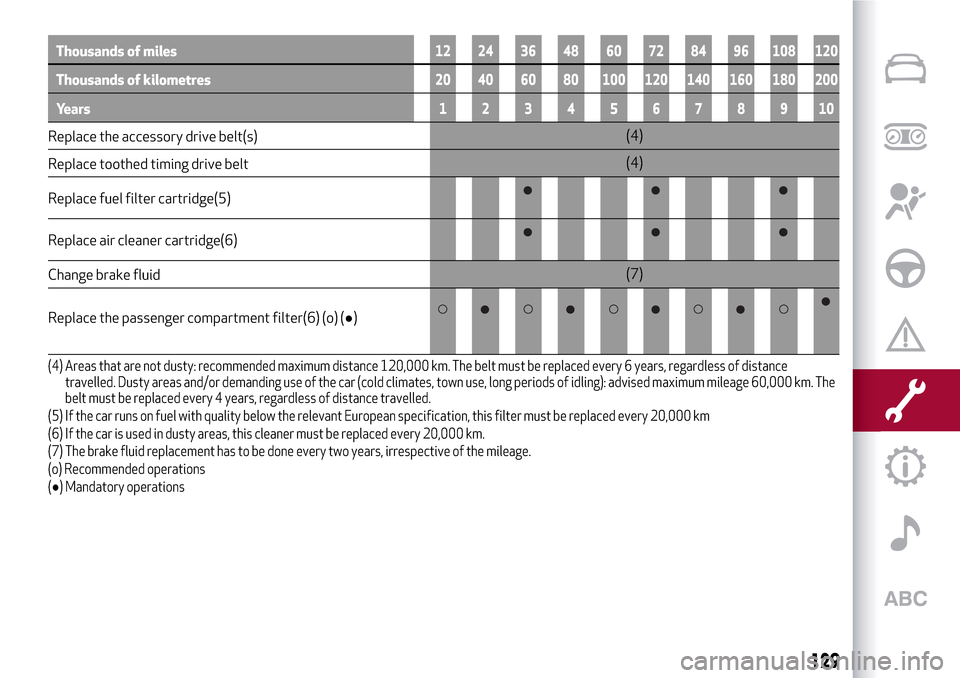
Thousands of miles12 24 36 48 60 72 84 96 108 120
Thousands of kilometres20 40 60 80 100 120 140 160 180 200
Years12345678910
Replace the accessory drive belt(s)(4)
Replace toothed timing drive belt(4)
Replace fuel filter cartridge(5)
Replace air cleaner cartridge(6)
Change brake fluid(7)
Replace the passenger compartment filter(6) (o) (●)
(4) Areas that are not dusty: recommended maximum distance 120,000 km. The belt must be replaced every 6 years, regardless of distance
travelled. Dusty areas and/or demanding use of the car (cold climates, town use, long periods of idling): advised maximum mileage 60,000 km. The
belt must be replaced every 4 years, regardless of distance travelled.
(5) If the car runs on fuel with quality below the relevant European specification, this filter must be replaced every 20,000 km
(6) If the car is used in dusty areas, this cleaner must be replaced every 20,000 km.
(7) The brake fluid replacement has to be done every two years, irrespective of the mileage.
(o) Recommended operations
(●) Mandatory operations
129
Page 132 of 212

PERIODIC CHECKS
Every 1,000 km or before long journeys,
check and, if necessary, top up the
following:
engine coolant, brake fluid and
windscreen washer fluid level;
tyre inflation pressure and condition;
operation of lighting system
(headlights, direction indicators, hazard
warning lights, etc.);
operation of screen wash/wipe system
and positioning/wear of windscreen/
rearscreen wiper blades
Check and top up, if required, the engine
oil level every 3,000 km.
IMPORTANT To find out the correct oil
quantity, always check using the dipstick.
Carry out the check with the vehicle
parked on level ground.
DEMANDING USE OF THE CAR
If the vehicle is used mainly under one of
the following conditions:
towing a trailer or caravan;
dusty roads;
short, repeated journeys (less than
7-8 km) at sub-zero outside
temperatures;
engine often idling or driving long
distances at low speeds or long periods
of inactivity;
the following checks must be carried out
more often than indicated in the
Scheduled Servicing Plan:
check front disc brake pad condition
and wear;
check cleanliness of bonnet and
luggage compartment locks, cleanliness
and lubrication of linkage;
visually inspect condition of: engine,
gearbox, transmission, pipes and hoses
(exhaust - fuel system - brakes) and
rubber elements (boots - sleeves - bushes
- etc.);
check battery charge and battery fluid
level (electrolyte);
visually inspect conditions of the
accessory drive belts;
check and, if necessary, change engine
oil and replace oil filter;
check and, if necessary, replace pollen
filter;
check and, if necessary, replace air
cleaner.
130
SERVICING AND MAINTENANCE
Page 138 of 212

134)The cooling system is pressurised. If
necessary, only replace the plug with
another original or the operation of the
system may be adversely affected. Do not
remove the reservoir plug when the engine is
hot: you risk scalding yourself.
135)Do not travel with the windscreen
washer fluid reservoir empty: the
windscreen washer is essential for
improving visibility. Repeated operation of
the system without fluid could damage or
cause rapid deterioration of some system
components.
136)Some commercial additives for
windscreen washer fluid are flammable. The
engine compartment contains hot
components which may start a fire.
137)Brake fluid is poisonous and highly
corrosive. In the event of accidental contact,
immediately wash the affected parts with
water and mild soap. Then rinse thoroughly.
Call a doctor immediately if swallowed.
138)The symbol
, on the brake fluid
container indicates if a brake fluid is
synthetic or mineral-based. Use of mineral
type fluids will damage the special rubber
seals of the braking system beyond repair.
IMPORTANT
3)Used engine oil and oil filters contain
substances which are harmful to the
environment. To change the oil and filters, we
advise you to contact an Alfa Romeo
Dealership.
4)Used transmission fluid contains
substances that are harmful to the
environment. You are advised to contact an
Alfa Romeo Dealership for oil changes.
BATTERY RECHARGING
IMPORTANT The battery recharging
procedure is given as information only. To
carry out this operation contact an Alfa
Romeo Dealership.
IMPORTANT After turning the ignition
key to STOP and having closed the
driver's side door, wait at least one
minute before disconnecting and then
reconnecting the electrical supply to the
battery.
Charging should be slow at a low ampere
rating for approximately 24 hours.
Charging for a longer time may damage
the battery.
IMPORTANT The cables of the electrical
system must be correctly reconnected to
the battery, i.e. the positive cable (+) to
the positive terminal and the negative
cable (–) to the negative terminal. The
battery terminals are marked with the
positive (+) and negative (–) symbols, and
are shown on the battery cover. The
battery terminals must also be
corrosion-free and firmly secured to the
terminals. If a "quick-type" battery
charger is used with the battery fitted on
the vehicle, before connecting it
disconnect both cables of the battery
itself. Do not use a "quick-type" battery
charger to provide the starting voltage.The cables of the electrical system must
be correctly reconnected to the battery,
i.e. the positive cable (+) to the positive
terminal and the negative cable (–) to the
negative terminal. The battery terminals
are marked with the positive (+) and
negative (–) symbols, and are shown on
the battery cover. The battery terminals
must also be corrosion-free and firmly
secured to the terminals.
VERSIONS WITHOUT START&STOP
SYSTEM
(for versions/markets, where provided)
To recharge, proceed as follows:
disconnect the terminal from the
negative battery pole;
connect the charger cables to the
battery terminals, observing the polarity;
turn on the charger;
when it is recharged, turn the charger
off before disconnecting it from the
battery;
reconnect the terminal to the negative
battery pole.
VERSIONS WITH START&STOP
SYSTEM
(for versions/markets, where provided)
To recharge, proceed as follows:
disconnect the connector 1 fig. 122
(pressing the button 2) from the sensor
3 monitoring the battery conditions, on
the negative pole (–) 4 of the battery;
136
SERVICING AND MAINTENANCE
Page 139 of 212

connect the positive cable (+) of the
battery charger to the positive battery
terminal 5 and the negative cable (–) to
sensor terminal 4 as shown in fig. 123;
turn on the battery charger. At the end
of the charging process, switch the
battery charger off;
after having disconnected the
charging device, reconnect connector
1 to the sensor 3 as shown.
AIR CLEANER/POLLEN
FILTER/DIESEL FILTER
For filter replacement, contact an Alfa
Romeo Dealership.
NOZZLES
139)
46)
Windscreen washer
The window washer nozzles are fixed. If
there is no jet of fluid, first check that
there is some fluid in the reservoir (see
paragraph "Checking fluid levels"). Then
check that the nozzle holes are not
clogged, if necessary use a needle.
WARNING In versions with sun roof,
make sure that the roof is closed before
operating the windscreen washer
nozzles.
Rear window washer
The nozzle holder is on the rear window.
The rear window washer jets are fixed.
122A0K0530AC
123A0K0530BC
137
Page 160 of 212
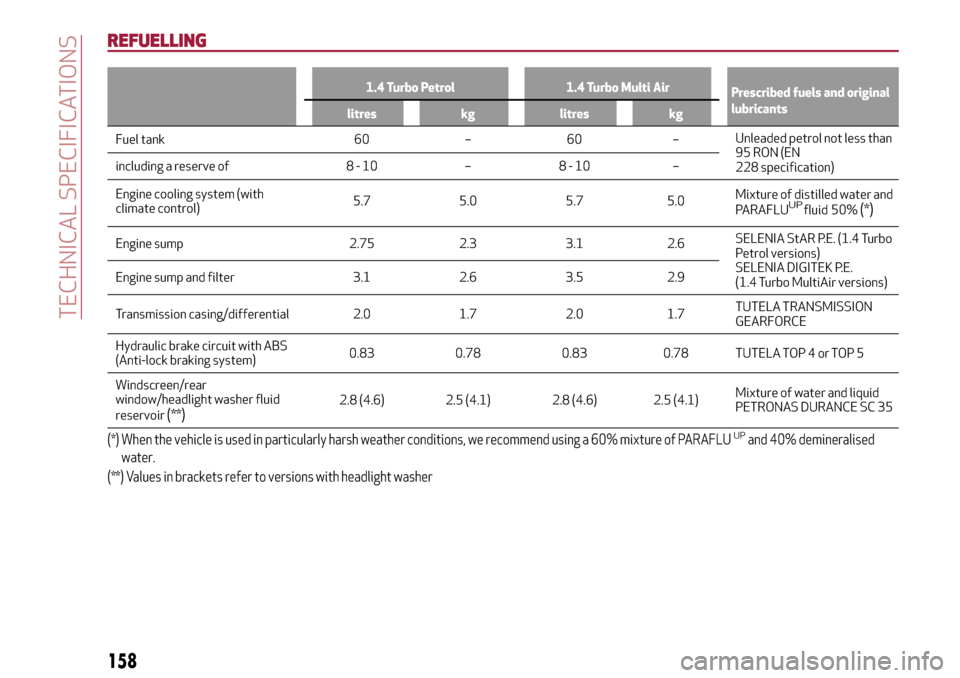
REFUELLING
1.4 Turbo Petrol 1.4 Turbo Multi Air
Prescribed fuels and original
lubricants
litres kg litres kg
Fuel tank 60 – 60 –Unleaded petrol not less than
95 RON (EN
228 specification) including a reserve of 8 - 10 – 8 - 10 –
Engine cooling system (with
climate control)5.7 5.0 5.7 5.0Mixture of distilled water and
PARAFLU fluid
UP50%(*)
Engine sump 2.75 2.3 3.1 2.6SELENIA StAR P.E. (1.4 Turbo
Petrol versions)
SELENIA DIGITEK P.E.
(1.4 Turbo MultiAir versions) Engine sump and filter 3.1 2.6 3.5 2.9
Transmission casing/differential 2.0 1.7 2.0 1.7TUTELA TRANSMISSION
GEARFORCE
Hydraulic brake circuit with ABS
(Anti-lock braking system)0.83 0.78 0.83 0.78 TUTELA TOP 4 or TOP 5
Windscreen/rear
window/headlight washer fluid
reservoir
(**)2.8 (4.6) 2.5 (4.1) 2.8 (4.6) 2.5 (4.1)Mixture of water and liquid
PETRONAS DURANCE SC 35
(*) When the vehicle is used in particularly harsh weather conditions, we recommend using a 60% mixture of PARAFLUUPand 40% demineralised
water.
(**) Values in brackets refer to versions with headlight washer
158
TECHNICAL SPECIFICATIONS
Page 201 of 212
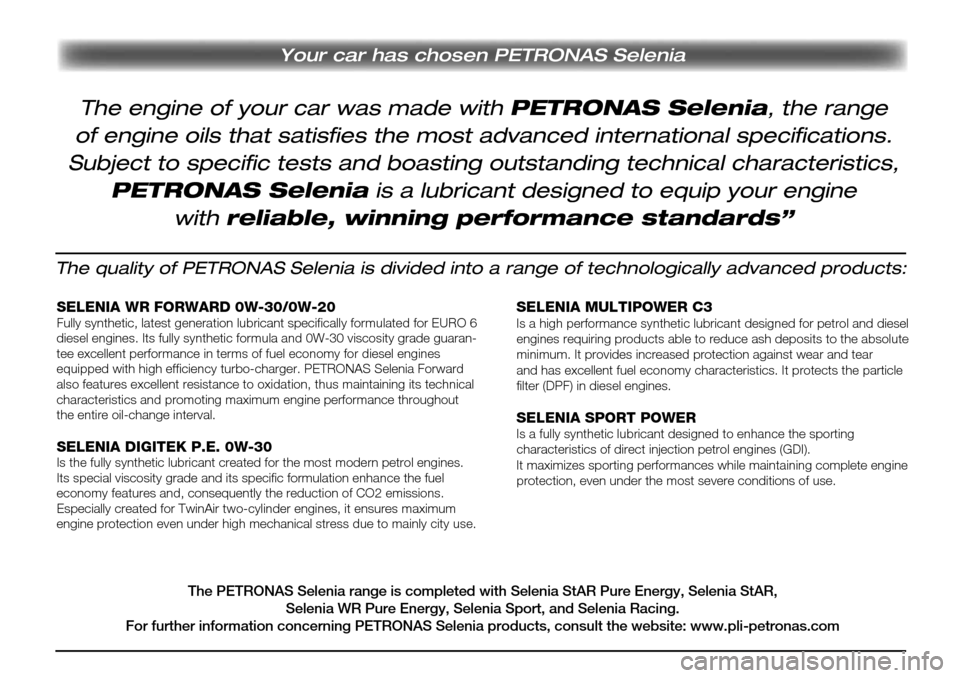
Your car has chosen PETRONAS Selenia
The quality of PETRONAS Selenia is divided into a range of technologically advanced products:
SELENIA WR FORWARD 0W-30/0W-20Fully synthetic, latest generation lubricant specifically formulated for EURO 6
diesel engines. Its fully synthetic formula and 0W-30 viscosity grade guaran-
tee excellent performance in terms of fuel economy for diesel engines
equipped with high efficiency turbo-charger. PETRONAS Selenia Forward
also features excellent resistance to oxidation, thus maintaining its technical
characteristics and promoting maximum engine performance throughout
the entire oil-change interval.
SELENIA DIGITEK P.E. 0W-30Is the fully synthetic lubricant created for the most modern petrol engines.
Its special viscosity grade and its specific formulation enhance the fuel
economy features and, consequently the reduction of CO2 emissions.
Especially created for TwinAir two-cylinder engines, it ensures maximum
engine protection even under high mechanical stress due to mainly city use.
SELENIA MULTIPOWER C3Is a high performance synthetic lubricant designed for petrol and diesel
engines requiring products able to reduce ash deposits to the absolute
minimum. It provides increased protection against wear and tear
and has excellent fuel economy characteristics. It protects the particle
filter (DPF) in diesel engines.
SELENIA SPORT POWERIs a fully synthetic lubricant designed to enhance the sporting
characteristics of direct injection petrol engines (GDI).
It maximizes sporting performances while maintaining complete engine
protection, even under the most severe conditions of use.
The PETRONAS Selenia range is completed with Selenia StAR Pure Energy, Selenia StAR,
Selenia WR Pure Energy, Selenia Sport, and Selenia Racing.
For further information concerning PETRONAS Selenia products, consult the website: www.pli-petronas.com
The engine of your car was made with PETRONAS Selenia, the range
of engine oils that satisfies the most advanced international specifications.
Subject to specific tests and boasting outstanding technical characteristics,
PETRONAS Selenia is a lubricant designed to equip your engine
with reliable, winning performance standards”
Page 207 of 212

INDEX
Alfa DNA” system.............31
ABS system................60
Active safety systems...........60
AFS adaptive lights (Adaptive
Frontlight System)...........19
Air cleaner.................137
Alarm system................11
Alfa Romeo Code system.........10
ALFATCT..................83
Key removal..............117
ASR (AntiSlip Regulation) system....60
Automatic dual-zone climate
control system.............24
AUX source.............179 ,191
Battery..................138
advice for extending its life.....138
replacement..............138
Battery (recharging)...........136
Bluetooth®..............179 ,190
Bodywork
maintenance..............140
Boot.....................30
Brakes
brake fluid level............135
Carrying children safely
.........68
CBC (Cornering Brake Control)
system..................61Changing a wheel.............110
Checking levels..............131
Cleaning and maintenance
bodywork...............140
car interior...............141
front headlights............141
leather parts..............142
leather seats..............141
plastic and coated parts.......142
seats and fabric parts........141
Climate control system..........22
CO2 emissions..............168
Control buttons...............38
Control panel and on-board
instruments...............36
Reconfigurable multifunction
display..................36
CONTROLS
Front panel control summary
table..................186
Courtesy lights
Front ceiling light............20
Cruise Control...............89
Daytime running lights (DRL)......17
Diesel filter................137
Dimensions................154
Dipped headlights
bulb replacement . .........
.100
Direction indicators............19
“Lane change” function........19bulb replacement........100 ,101
Display....................38
Doors.....................11
Child safety device...........12
Door central locking/unlocking....11
DST system (Dynamic Steering
Torque)..................60
Dusk sensor . . ...............17
EBD system................60
Electric sunroof..............27
Electric windows..............26
Controls.................26
Engine...................146
engine coolant level.........135
marking . . ...............145
Engine bonnet . . .............29
Closing..................29
Opening.................29
Engine compartment
washing . . ...............141
Engine oil
consumption..............135
level check...............135
ESC (Electronic Stability Control)
system..................60
External courtesy lights..........19
"
Electronic Q2" system ("E-Q2")
....61 "
External lights...............17